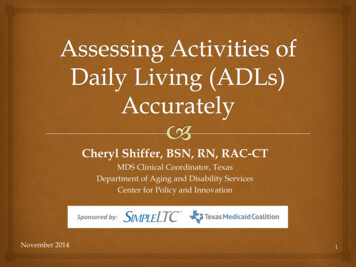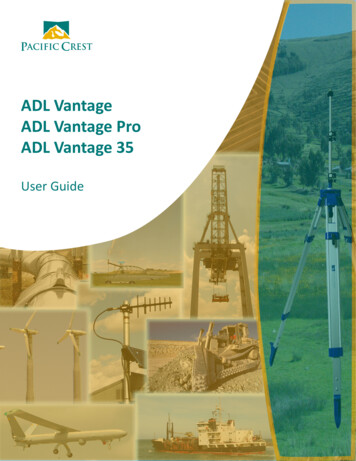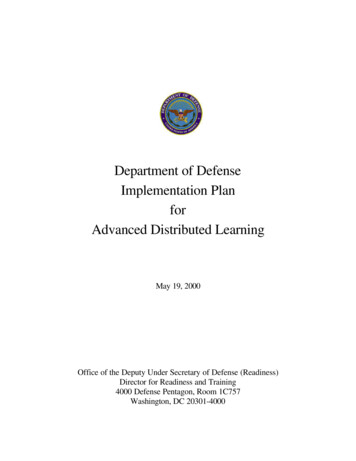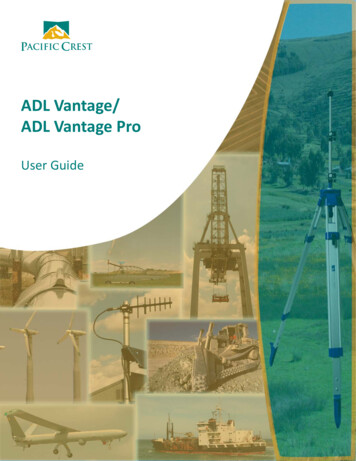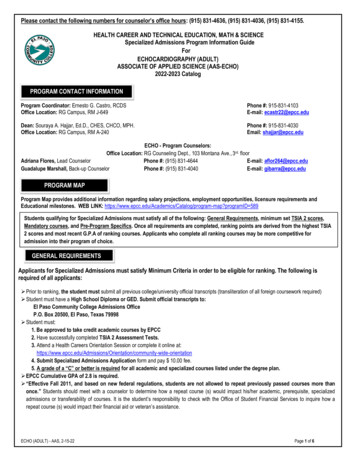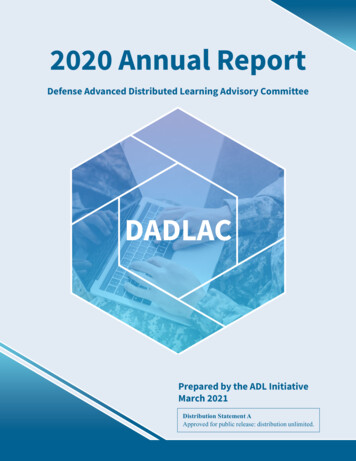
Transcription
2020 Annual ReportDefense Advanced Distributed Learning Advisory CommitteeDADLACPrepared by the ADL InitiativeMarch 2021Distribution Statement AApproved for public release: distribution unlimited.
Table of ContentsMessage from the DADLAC Chair.3DADLAC History.4Year in Review.6Policies in Review.14COVID-19 and Beyond.16Technology Transfer and Modernization Success Stories.20Mark Your Calendars! 2021 Plans.24The DADLAC enables connectionsamong learning efforts and initiativesacross DoD, elevating and enriching the effortsand results for everyone. The DADLAC is the“electricity” that is powering transformationalchange for DoD!Amy RogersChief Learning Officer,Defense Civilian Personnel Advisory Service2
Message from the DADLAC ChairLast year was filled with chaos, but from that crisis came opportunities—opportunities toreinvent the reputation and purpose of distributed learning, and to reimagine its uses aroundthe world. We faced a sink-or-swim moment, and I’m proud to say that this communityexcelled. Distributed learning emerged as a silver lining to the year’s hardships. We met lastyear’s unprecedented demands, and the value of our DADLAC community was demonstratedtime and again as we collectively—and successfully—accelerated and expanded defensedistributed learning by orders of magnitude. This report highlights our community’sactivities, along with important policies and plans impacting our respective programs.This year we.Quickly pivoted in response to the pandemic. Individual programs scaled rapidly to address the increasedneed for distributed learning, and as a community, we adapted. For example, we changed our face-to-facemeetings into online forums and remade the annual Federal e-Learning Science and Technology (iFEST)conference into a virtual event.Worked together on digital learning R&D projects organized by the ADL Initiative, including test-driv ingnew technologies in the Total Learning Architecture sandbox and participating in the designatedstakeholder program. Check out the Success Stories section of the report for more on this!Made progress toward the future learning ecosystem vision by maturing digital learning data standardsin coordination with industry working groups, testing emerging digital learning technologies, andim plementing new capabilities within our own organizations. DADLAC member organizations aremaking great strides, particularly in new technologies, interoperability, personalized learning, dataanalytics, and cybersecurity compliance. See the Member Updates section on page 7.Expanded our reach across the DoD enterprise by including new member organizations, streamlining ourcoordination methods, and building connections to other working groups. Today, over 250 individualsparticipate in the DADLAC, representing all DoD Services, other Defense Components such as theDe fense Civilian Personnel Advisory Service and Defense Acquisition University, as well as otherFederal organizations, including the Office of Personnel Management.It’s become the 2020 cliché to say that this is the new normal, and although that expression may have grownstale, its veracity is untarnished. We’ve entered a new era for distributed learning, and I predict that our manyaccomplishments from today will soon pale in comparison to the advancements we make in the upcoming years.I’m hopeful for the future, and I know that this community is poised to seize the opportunity.Sae Schatz, Ph.D.Director, Advanced Distributed Learning InitiativeU.S. Department of Defense3
2020DADLAC HistoryFor over twenty years, distributed learning leaders across DoD have collaborated, learning from each other’sefforts and continuously improving our collective use of distributed learning. Originally established in 1997, thiscommunity was called the Total Force Advanced Distributed Learning Action Team. In 2017, the policy governingthis group, Defense Instruction 1322.26, was updated, and we were renamed the Defense Advanced DistributedLearning Advisory Committee or DADLAC (pronounced dad-lak). This Defense Instruction also includes theDADLAC charter, which outlines the assignment of roles and responsibilities. It directs the DADLAC to adviseon distributed learning policy, exchange information, and collaborate on emerging concepts relevant to the DoDcommunity.The DADLAC enables critical information andresource sharing among DoD Components. Italso helps maximize return on investments andidentify ways to improve distributed learningsystems and their reuse. The DADLAC alsohelps identify common areas of need and torecommend priorities for R&D. In addition, theDADLAC provides updates to the DoDI 1322.26Fungible References, which defines the technical requirements and best practices for distributed learning systems.DADLAC MissionThe DADLAC provides advice to the DoD distributedlearning community with respect to the policies andprocedures included in Defense Instruction 1322.26,and it helps the DoD distributed learning communityadapt to evolving learning science and technicalchanges in distributed learning environments.Member OrganizationsThe ADL Initiative, part of the Office of the Secretary of Defense, serves as the DADLAC Chair and advises DoDleadership on current and proposed distributed learning activities. DADLAC members include designated military andcivilian distributed learning leaders, as well as guests from across the greater DoD and U.S. Government distributedlearning communities. The next page shows a cross section of organizations that participate with the DADLAC.4
DADLAC Participating OrganizationsDADLAC ChairAdvanced Distributed Learning InitiativeArmyNavyMarine CorpsAir ForceThe Army Distributed LearningProgramNaval Education andTraining CommandMarine Corps Training andEducation CommandAir Education and Training CommandArmy Training and DoctrineCommandNaval Air Warfare Center(Training Systems Division)College of Distance Educationand TrainingAir UniversityArmy Training InformationSystemNaval Information WarfareCenter (Pacific)TECOM Training CommandAir Force Agency for Modelingand SimulationArmy UniversityMarine Corps Combat Development CommandAir Force ResearchLaboratoryArmy War CollegeNaval Medical ForcesSupport CommandMarine Corps UniversityU.S. Space ForceArmy Command and GeneralStaff CollegeNaval Postgraduate SchoolArmy Combined Arms SupportCommandArmy Training Support CenterDEVCOM ArmyResearch LaboratoryNaval War CollegeNaval Medical Research CenterNaval Sea System CommandOffice of the NavalInspector GeneralOffice of Naval ResearchNote: Illustration represents a cross section of the DoD andU.S. Government organizations participating in the DADLACactivities supported by the ADL Initiative.This is not exclusive —all government organizations interestedin participating or receiving updates on DADLAC efforts areencouraged to join our email list (see page 13).DoD 4th EstateGovernment AgenciesDefense Acquisition UniversityDepartment of EducationDefense Civilian PersonnelAdvisory ServiceDepartment of Housing andUrban DevelopmentDefense Counterintelligenceand Security AgencyDepartment of LaborDefense Health AgencyFederal Bureau of I nvestigationDefense Intelligence AgencyFederal EmergencyManagement AgencyDefense InformationSystems AgencyDepartment ofHomeland SecurityDefense Logistics AgencyNational Park ServiceDefense Language and NationalSecurity Education OfficeOffice of PersonnelManagementJoint Staff J7, Joint KnowledgeOnlineMissile Defense AgencyNational Defense UniversityNational GeospatialIntelligence AgencyNational Guard BureauNational Security AgencyNational Reconnaissance OfficeOffice of People AnalyticsOffice of the ChiefInformation OfficerUniformed Services Universityof the Health Sciences
2020Year in ReviewVirtual DADLAC Meeting HighlightsDADLAC meetings give members the opportunity to reconnect, strengthen relationships, and learn first-handabout each other’s progress and pain points. The formal DADLAC meetings (typically held in April and August)feature member updates, policy discussions, and product demonstrations. Although COVID-19 prevented us fromconnecting in-person, last year’s three virtual meetings were productive.ADL Initiative 2020 R&D PortfolioThe 8 April 2020 DADLAC meeting focused on the ADL Initiative’s FY20 R&D portfolio, including discussionson the Total Learning Architecture (TLA) and Learning Technology Warehouse.First, the ADL Initiative shared the (then) newly released 2019 TLA Reportthat defines technology and data specifications for interoperable, data-centriclearning systems (i.e., a “learning ecosystem”). The TLA project started in 2016with the strategic vision of establishing an integrated system of systems acrossthe education and training domain. The TLA will enable data to be used, shared,and moved efficiently across the organization—creating optimization throughpersonalized learning, improved analytics, and efficiencies gained throughdata-driven management.Total Learning Architecture,2019 ReportThe 2019 TLA Report includes a four-pillar data strategy that encompasses:(1) learning activities (output data), (2) learning experiences (such as courses),(3) learner profiles, and (4) competencies. In addition to defining the datastrategy, the report’s appendices detail the TLA’s 2019 functional requirements,recommended draft standards, an initial architecture that conforms to the DoDArchitectural Framework (DoDAF), and a software system design documentbuilt around the 2019 TLA Reference Implementation (also known as the TLASandbox).The ADL Initiative team also shared progress on the TLA Sandbox, which resides on commercial cloud servers,managed by the Office of Personnel Management’s (OPM) USALearning program. The TLA Sandbox is adevelopment and testing environment, and the software within it adheres to the draft TLA specifications. That meansthe Sandbox can be used by DoD organizations to explore the TLA specification or test products for complianceto them. Lastly, the ADL Initiative team demonstrated its DevSecOps end-point portal, dubbed the LearningTechnology Warehouse. DADLAC members can access approved software through this app store–like portal,after the applications have been developed and tested through the corresponding DevSecOps pipeline. Althoughstill under development, future software packages will be made available in the portal for rapid deployment intothe DoD enterprise learning enclave or into stakeholders’ own environments. This will help reduce duplication ofR&D efforts by providing a clearinghouse where solutions are verified, adherent to interoperability specifications,and nearly “ready to use.”6
DADLAC Member UpdatesThe 7 May and 9 September 2020 meetings focused on updates from DADLAC member organizations.The Army Distributed Learning Program – Helen RemilyThe Army Distributed Learning Program (TADLP) aims to improve Armyreadiness by providing rigorous, relevant, and tailored distributed education andtraining to Soldiers, leaders, and Army civilians. There is a focus on providinglearning content at the point of need, with a learner-centric, career-long continuumof learning that is persistently accessible. TADLP has developed innovativeand engaging courseware products using the latest instructional technologies.Helen RemilyImmersive products being developed include 3D models delivered in virtualArmy Distributedenvironments, virtual and augmented reality, Experience API (xAPI) withLearning Programinstructional dashboards, level 3 development of foreign language courses, stealthDirectorassessments, and gamification—all while migrating away from existing Flash courseware. Progress is also being made on distributed learning projects that include a blended learningpilot, a distributed learning course catalog, a distributed enterprise asset repository, mobile publishing, andapps using xAPI and augmented reality. The learning apps effort includes an early concept demonstrationin a development environment (i.e., without the levels of cybersecurity that other networks and apps willneed). TADLP offers over 400 mobile apps that have been fielded, and over700 stand-alone online courses in the Army Learning Management System(ALMS). When including the Lifelong Learning Centers (LLCs), themajority of which are teaching in Blended Learning / Distributed Learning(BL/DL) Modality, the total offerings exceed 3300 courses. Lookingforward, TADLP continues to enhance the Army distributed learningsystems in conjunction with the current DoD-wide modernization efforts.Right: The Army is prototyping several new DL/VR projects as part of their transformation. Visit Vimeo to view one of their demos: PWD 92W 3K ROWPU VirtualTraining & 92F Virtual Reality DemonstrationNaval Education and Training Command – Michele HarrisonThe Navy is undertaking a broad modernization initiative aligned with the ReadyRelevant Learning program, which is one of three pillars of Sailor 2025. ReadyRelevant Learning focuses on aligning Navy learning into a continuum andleverag ing learning technology to support learning throughout the hire to retirecycle of individual Sailors. The goal is to deliver training faster and at the righttime to the Sailors who need it. To support this, Naval Educa tion and TrainingCommand (NETC) is developing MyNavy Learning (MNL). MNL is a totalMichele HarrisonStrategic Planning,learning architecture (TLA) that recommends and delivers point-of-need education,Metrics Management,training and professional development resources that are per sonalized to theand Research &Sailor using artificial intelligence and the Sailor’s individual learner profile. MNLDevelopment Branchis designed from the ground up to integrate holistically with new and upcomingHeadNavy personnel management systems to provide a single entry point for usersthat is intuitive and easy to navigate. In addition, MNL provides a federated system for updating, storing,and displaying each Sailor’s individual training record and qualifications presented in an innovative, userfocused format to keep the Sailor abreast of advancement requirements and upcoming training deadlines.This tool will help Sailors manage not only their training, but their progression throughout their entiremilitary careers.7
Defense Acquisition University – Shawn MillerShawn MillerTechnology Innovation TransformationProgram ManagerIn 2020, the Defense Acquisition University (DAU) provided over 10 millionhours of learning, graduated over 216,000 students, and awarded 647,000 studentswith continuous learning completion certificates. Recently, DAU has focused onmodernizing its capabilities including research into xAPI Learning Record Storedesign and use cases, xAPI applications for personalization and data analyticspilot projects, and AI and adaptive learning capabilities. DAU is exploring howto best provide interoperability to connect learning systems and access data topersonalize its offerings as much as possible to meet customers at their pointof need. This will enable DAU to inform immediate learning path decisions forindividuals and provide recommendations that improve the learning experience,for example, aggregating analytics to curate and anticipate what students need.DAU is also working with the ADL Initiative’s TLA Sandbox to integrate and testthese technologies.The value of DADLAC participation is being a part of a forward leaning community of expertsand problem-solvers that knowledge-share and team on complex tasks. We collaborate tosolve pieces of the puzzle for big picture efforts like greater personalization for learners,xAPI Profiles development, Total Learning Architecture, and Enterprise Digital LearningModernization (EDLM).Shawn MillerDefense Acquisition UniversityJoint Staff J7, Joint Knowledge Online – Howard ThorpThe Joint Staff J7 Directorate is responsible for joint warfighter development,includ ing education, training, and exercises. Joint Knowledge Online (JKO) is anopera tional arm of the Joint Staff J7. Its mission is to provide 24/7 global access toclassified and unclassified distributed training platforms and online courses. TheJKO team includes technology and instructional systems design experts who develop, manage, and advance web-based training for the Combatant Commands,Howard ThorpServices, Joint Staff, and other stakeholders. The JKO environment includes aChief, Jointlearning management system for deKnowledgelivering, tracking, and reporting onOnline Divisiononline courses; the Small Group Scenario Trainer for distributed, collaborative staff training; andthe Virtual Classroom for online, instructor-led distributedlearning. During the past summer, JKO launched new softwareupdates to enhance its platform with a stronger cybersecurity posture, a modernized user in terface, an updated responsiveweb design, and an easier search feature. JKO is working onseveral projects including an adaptive learning methodologypilot and partnering with NORTHCOM on the Vigilant Shieldexercise to stand up a Five Eyes capability network on JKO.8
Air Education and Training Command – Floyd McKinneyAir Education and Training Command (AETC) serves more than 29,000 ActiveDuty members, 6000 Air National Guard and Air Force Reserve personnel, and14,000 civilians. A transformative effort to migrate legacy Air Force learningsystems and content into acommon IT environment formally named “myLearning” isFloyd McKinneycurrently in progress under aChief, Learningproject called Joint EducationServices Operations,and Training System (JETS).AETCThe new myLearning servicewill operate, manage, and deliver Air Force learningcapabilities to all Airmen—anytime, anywhere. AETChas established a new division to implement and managethis learning services operating environment, and it aimsto make the initial service-wide capability available inSpring 2021.Marine Corps Training and Education Command – Larry SmithTraining and Education Command (TECOM) leads the Marine Corps continuum oflearning, from individual entry-level training, professional military education, andcontinuous professional development, through unit, collective, and service-leveltraining. Currently, TECOM is working on several efforts to improve its learningarchitecture. One effort is an evaluation of xAPI Learning Record Stores, with thegoal of identifying the education and training data needed to get a better snapshotLarry Smithof a Marine’s overall training. TECOM’s distance education program has shiftedMarine Corpsthe hosting of its Moodle LMSUniversity Directorto an internally-acquired comof Ed Tech/College ofmercial cloud environment.Distance Educationand TrainingTransitioning to this environTechnical Directorment will help achieve costsavings, in part because it allows other software and learning ecosystem subsystemsused by TECOM to reside in the same environment.Finally, TECOM is furthering its use of MarineNetVideo Services—the Marine Corps version of a moderated YouTube. In 2020, more than 1,500 videos and 170different channels were made available by the video service. In the future, MarineNet will also provide podcastsand other media features for displaying, searching, andcurating content.9
Defense Health Agency – Ruben GarzaDefense Medical Modeling and Simulation OfficeThe Defense Medical Modeling and Simulation Office (DMMSO) was establishedby the Defense Health Agency (DHA) Director in 2016. This office serves as the leadorganization for the centralized management of shared service medical modelingand simulation (MM&S) capabilities and solutions to support medical educationand training. DMMSO’s joint office, located in San Antonio, is a collaborationRuben Garzahub for Army, Navy, and Air Force medical simulation program offices.Director, DMMSODMMSO promotes the use of MM&S across the DoD, and it helps to identify theappropriate simulation tools to fit gaps andmeet the requirements of customers—withthe goal of improving medical readiness,survivability, quality of care, patientsafety, and efficiency. In 2020, DMMSOspearheaded a year-long effort to integrateinterrelated DoD simulation organizationsinto a more structured arrangement, toreduce the isolation of medical simulationorganizations and improve interaction acrossthe force. DMMSO is also partnering withthe DADLAC community to ensure a smoothcontinuum between simulation-based trainingand other digital learning modalities.Defense Health Agency – Lolita O’DonnellContinuing Education Program OfficeThe DHA, J-7, Continuing Education Program Office (CEPO) assesses,reviews, and awards Continuing Education (CE)/Continuing Medical Education(CME) credits within the CE Management System (CMS). Prior to 2017, DHAoffered CE/CME for physicians and nurses. Since joining DHAJ-7, CEPO received approval as an accreditedLolita O’Donnellprovider for more than 16 other accreditationsDirector, CEPOto include pharmacists and pharmacytechnicians, physician assistants, optometrists, social workers, andpsychologists. In 2020, CEPO expanded its certification offerings tosupport dental practitioners, dietitians and dietetic technicians, and speechlanguage pathologists and audiologists. CEPO also successfully plannedand executed the FY20 DHA Clinical Communities Speaker Seriesvirtually, where the CE/CME educational activities enhanced quality ofcare, patient outcomes and population health by improving the practiceskills and clinical knowledge of health care providers across the militaryhealth care system.10
Defense Civilian Personnel Advisory Service – Amy RogersThe Defense Civilian Personnel Advisory Service (DCPAS) develops, implements,and monitors DoD civilian human resources, including leadership programs, careerand professional development, and the human resources functional community.DCPAS undertook several efforts in 2020 that impact learning infrastructure andprogramming. One initiative aims to reduce the number of LMSs in the “FourthEstate” (i.e., outside of the military services) from 17 to 14 by 2024. AnotherAmy Rogerseffort will revise and consolidate DCPAS training, education, and professionalChief Learningdevelopment policies—one of many efforts streamlining the existing 90 DefenseOfficer for theInstructions and providing more integrated and modern guidance. A third effortCivilian Workforceis updating the DoD Leaders Competency Model, which was last reviewed fiveyears ago; that update is anticipated to be released in 2021. Additionally, DCPAS leads the Defense ChiefLearning Officer Council (DCLOC), a DoD-wide working group. The DCLOC established a number ofcommunities to institute a coaching culture across DoD. These communities of interest will help establishan in-house coaching training program and address the inconsistency of tools available across the DoDlearning and development community. DCPAS is also looking into an awards working group to recognizethe great work and skills of the DCLOC community. DADLAC members are invited to participate with anyof these groups.Members Helping Members: An Example of CollaborationShared by Floyd McKinney, Chief, Learning Services Operations, AETCThe DADLAC provides the Air Force with the continuing abilityto share information and collaborate with other DoD componentsin meaningful ways that would be difficult to achieve otherwise.The DADLAC facilitates the long-standing, close relationshipsAETC maintains with our ADL counterparts across DoD by holdingmeetings annually as well as by promoting more frequent virtualcommunications. In 2020, AETC participated in the recurringDADLAC meetings, as well as the ADL Initiative Principal Investigator (PI) meeting, and the annual Federal E-Learning Science &Technology (iFEST) conference.In addition to these meetings and events, AETC participated in technical projects led by the ADL Initiative,which include varying mixes of DoD Components. These projects are intended to advance ADL capabilities to increase readiness, facilitate interoperability, or otherwise enhance mission execution. In addition,the projects provide more extensive opportunities for participants to share deeper technical information tothe benefit of all involved. During FY 2020, AETC specifically participated in TLA, Enterprise Learner Record Repository Prototype, and EDLM efforts.One significant area where Airmen will see the effects of these various 2020 activities is the outcome ofAETC’s collaboration with the Navy and Marine Corps to select the new LMS to replace the aging AirForce Advanced Distributed Learning Service (ADLS) and the Enterprise Blended Learning Service. TheNavy and Marine Corps shared information, experiences, and lessons learned with AETC as they acquiredtheir respective Moodle LMSs. AETC utilized the valuable information received as part of our analysis toalso select Moodle as the foundation for our replacement. AETC would not have had access to the Navyand Marine experts without the facilitation provided by the DADLAC.11
DoD Instruction 1322.26 References UpdateDoD Instruction 1322.26 governs the implementation and oversight of distributed learning for the DoD. TheInstruction also includes fungible references, i.e., appendices that can be regularly updated by the DADLACwithout requiring entire revisions to the DoDI. These references outline the most current technical information forDoD learning, such as guidance on software specifications and file types. DoD Components should refer to the DoDInstruction and its references when acquiring or implementing distributed learning systems. The ADL Initiative andthe DADLAC update these references as needed, which is typically one to three times annually.Updates in 2020Metadata For Learning SystemsMetadata guidance was one of the two major updates to the references last year. Due to its growingusage in learning systems and courseware, it was important to provide direction on how to optimizelearning content metadata. Metadata provides information (e.g., author, file size, subject, title, duration)about learning activities and experiences. When creating learning resource metadata, DoD Componentsshould enforce the use of controlled vocabularies. This will help reduce ambiguity of learning dataand increase its use for education and training decision making, as well as improve interoperability oflearning systems and searchability of learning resources.Technical Standards GuidanceThe references include specifications and standards DoD should consider when acquiring distributedlearning solutions. In 2020, this section was expanded to include updated xAPI standard informationand new cmi5 specification guidance. The DoD is encouraged to start using the cmi5 specification(which expands upon SCORM functionality) with the intention of replacing SCORM as the de-factoformat of online courses and traditional computer-based training.New GlossaryIn addition to contributing to reference revisions, the DADLAC requested and approved the additionof a glossary of distributed learning terms. It’s located in the resources section of the ADL Initiativewebsite: https://www.adlnet.gov/resources.Upcoming Updates for 2021In 2021, the DADLAC will be invited to vote on new guidance for the topics listed below. Identity, Credentials, and Access Management, and its impact on xAPI data Expanded guidance on cmi5 Expanded guidance on learning resource metadata, particularly for the semantic web Expanded guidance on competency-based learning, particularly data standards New xAPI information, given the upcoming v2.0 release and xAPI Profile ServerThe ADL Initiative will formally disseminate language on these updates to the DADLAC shortly after the new year.Collaboration will happen asynchronously and the updates will be finalized during a formal meeting.A New Look For the ReferencesThe DADLAC will soon have a more efficient way to access the DoDI references on ADLnet.gov. A new interactive version will enable users to search the references by key terms and user role. A downloadable PDF of thereferences will be available from the site.12
Communications with the CommunityDADLAC Commercial VirtualRemote EnvironmentLast year we established a CommercialVirtual Remote (CVR) Environmentchannel. DADLAC members can use itto access key resources including 2020virtual meeting notes and highlights,and copies of DADLAC digest emails.There’s also an interactive list ofupcoming events. (Note, CVR is onlyaccessible with a CVR account, whichrequires a valid .MIL email address.)DADLAC Digest EmailsAbove: Screenshot of the CVR DADLAC channelThe ADL Initiative sends digest emails regularly, summarizing new policies, resources, and member updates for theDADLAC community. These emails are one of the primary ways the community shares information. Members areencouraged to review and forward relevant materials to their teams and colleagues.Examples of resources sharedvia Email Updates in 2020Report to Congress on Implementation of Defense Science BoardReport Recommendations, “Design andAcquisition of Software for Defense Systems,” from Section 868 of the NationalDefense Authorization Act for FiscalYear 2019 (P.L. 115-232).The Defense Human Resources Activity’sPrivacy Playbook, which outlines guidance on how to maintain compliancewith federal law and DoD policy whencollecting, maintaining, safeguarding,and sharing personally identifiable information.xAPI Version 2.0 Standard: TheIEEE Learning Technology StandardsCommittee plans to standardize an updated version of the xAPI specification,dubbed version 2.0.Contact the ADL Initiative if yo
700 stand-alone online courses in the Army Learning Management System (ALMS). When including the Lifelong Learning Centers (LLCs), the majority of which are teaching in Blended Learning / Distributed Learning (BL/DL) Modality, the total offerings exceed 3300 courses. Looking forward, TADLP continues to enhance the Army distributed learning

